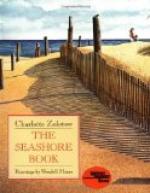Many sea-animals have wonderfully large families, but the Oyster, with its millions and millions of eggs, beats most of them. Strangely enough, its eggs are not sent into the sea at once, but are kept between the Oyster’s shells until they hatch. Needless to say, these babies are very small indeed, else their nursery could not contain them all Though so small that thousands of them together look more like a pinch of dust than anything else, yet each one has two thin shells; so that, if you eat the parent Oyster, they grate on your teeth like sand. Oysters, at this time, are “out of season”—that is, unfit for food.
At the right moment, the Oyster gets rid of its numerous family. It opens its shells, then shuts them rapidly; and, each time this happens, a cloud of young Oysters is puffed out like smoke. Now these mites must fend for themselves in a sea full of foes.
They have no defence, and countless numbers of them are gobbled up by crabs, anemones, and others. If this did not happen, the sea would soon be paved with Oysters.
For a time, the baby Oysters—which are known as “spat”—are able to swim here and there. In rough weather they are driven far into the deeps of the ocean, and lost. The rest of them, before they have been free for two days, settle on the bed of the sea—sometimes on their own parents; and there they remain for life. Only a very few out of each million become “grown-ups”—the rest are eaten by enemies, or smothered in mud or sand. In a year or so they are as big as half-a-crown. In five years they are fine, fat grown-up Oysters—that is to say, if they have not been dredged up from their bed and sent to market.
Their shells open and shut like a trap. You may have seen a picture of an inquisitive mouse trapped by an Oyster. Thinking to have a nice taste of Oyster, the mouse had poked its head into the open shells, but they were snapped together, and the mouse was firmly held in the trap.
Between the hinge of the two shells there is a pad, which acts like an elastic spring, and forces the shells open. The Oyster can close them by means of a strong muscle. They are its only defence, so it closes them at the least hint of danger.
Even these thick walls are sometimes of no avail, as we saw in our talk on “Five-fingered Jack.” We saw how the starfish forces the shells open with the help of its strong tube-feet. The whelk and his cousins know how to bore a hole in the shell, and suck out the helpless Oyster. Then there are certain sponges, with the strange habit of making holes in shells, and living in and on them. Sometimes the Oysters are stifled in their “beds” by other Oysters settling and growing over them. Thick masses of Mussels may cling to them and suffocate them. And grains of sand sometimes get in the hinges of their shells, so that they cannot close up the house when they wish.
Like the other animals which are useful as food, Oysters have been carefully studied and cultivated by man for many, many years. The story of the Oyster-beds is a long and interesting one.




